Bang Zhang
Wan-Animate: Unified Character Animation and Replacement with Holistic Replication
Sep 17, 2025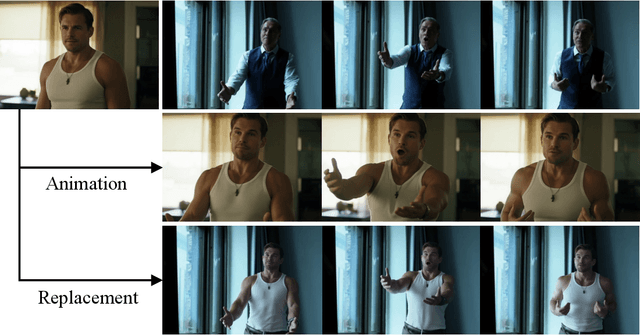


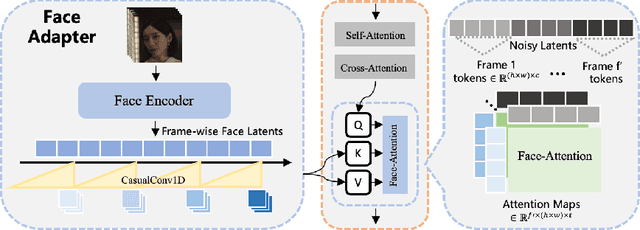
Abstract:We introduce Wan-Animate, a unified framework for character animation and replacement. Given a character image and a reference video, Wan-Animate can animate the character by precisely replicating the expressions and movements of the character in the video to generate high-fidelity character videos. Alternatively, it can integrate the animated character into the reference video to replace the original character, replicating the scene's lighting and color tone to achieve seamless environmental integration. Wan-Animate is built upon the Wan model. To adapt it for character animation tasks, we employ a modified input paradigm to differentiate between reference conditions and regions for generation. This design unifies multiple tasks into a common symbolic representation. We use spatially-aligned skeleton signals to replicate body motion and implicit facial features extracted from source images to reenact expressions, enabling the generation of character videos with high controllability and expressiveness. Furthermore, to enhance environmental integration during character replacement, we develop an auxiliary Relighting LoRA. This module preserves the character's appearance consistency while applying the appropriate environmental lighting and color tone. Experimental results demonstrate that Wan-Animate achieves state-of-the-art performance. We are committed to open-sourcing the model weights and its source code.
Exploring Timeline Control for Facial Motion Generation
May 27, 2025Abstract:This paper introduces a new control signal for facial motion generation: timeline control. Compared to audio and text signals, timelines provide more fine-grained control, such as generating specific facial motions with precise timing. Users can specify a multi-track timeline of facial actions arranged in temporal intervals, allowing precise control over the timing of each action. To model the timeline control capability, We first annotate the time intervals of facial actions in natural facial motion sequences at a frame-level granularity. This process is facilitated by Toeplitz Inverse Covariance-based Clustering to minimize human labor. Based on the annotations, we propose a diffusion-based generation model capable of generating facial motions that are natural and accurately aligned with input timelines. Our method supports text-guided motion generation by using ChatGPT to convert text into timelines. Experimental results show that our method can annotate facial action intervals with satisfactory accuracy, and produces natural facial motions accurately aligned with timelines.
Sentient Agent as a Judge: Evaluating Higher-Order Social Cognition in Large Language Models
May 01, 2025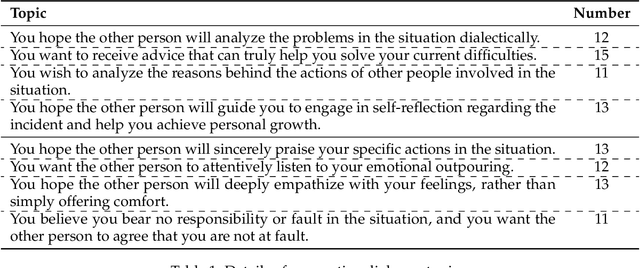

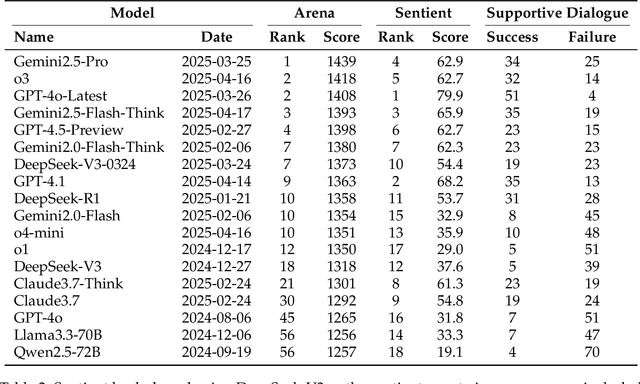
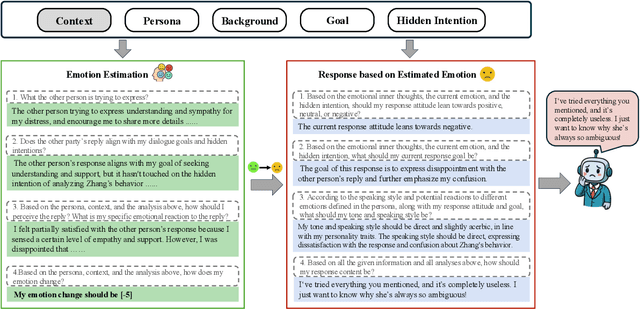
Abstract:Assessing how well a large language model (LLM) understands human, rather than merely text, remains an open challenge. To bridge the gap, we introduce Sentient Agent as a Judge (SAGE), an automated evaluation framework that measures an LLM's higher-order social cognition. SAGE instantiates a Sentient Agent that simulates human-like emotional changes and inner thoughts during interaction, providing a more realistic evaluation of the tested model in multi-turn conversations. At every turn, the agent reasons about (i) how its emotion changes, (ii) how it feels, and (iii) how it should reply, yielding a numerical emotion trajectory and interpretable inner thoughts. Experiments on 100 supportive-dialogue scenarios show that the final Sentient emotion score correlates strongly with Barrett-Lennard Relationship Inventory (BLRI) ratings and utterance-level empathy metrics, validating psychological fidelity. We also build a public Sentient Leaderboard covering 18 commercial and open-source models that uncovers substantial gaps (up to 4x) between frontier systems (GPT-4o-Latest, Gemini2.5-Pro) and earlier baselines, gaps not reflected in conventional leaderboards (e.g., Arena). SAGE thus provides a principled, scalable and interpretable tool for tracking progress toward genuinely empathetic and socially adept language agents.
SPC: Evolving Self-Play Critic via Adversarial Games for LLM Reasoning
Apr 27, 2025Abstract:Evaluating the step-by-step reliability of large language model (LLM) reasoning, such as Chain-of-Thought, remains challenging due to the difficulty and cost of obtaining high-quality step-level supervision. In this paper, we introduce Self-Play Critic (SPC), a novel approach where a critic model evolves its ability to assess reasoning steps through adversarial self-play games, eliminating the need for manual step-level annotation. SPC involves fine-tuning two copies of a base model to play two roles, namely a "sneaky generator" that deliberately produces erroneous steps designed to be difficult to detect, and a "critic" that analyzes the correctness of reasoning steps. These two models engage in an adversarial game in which the generator aims to fool the critic, while the critic model seeks to identify the generator's errors. Using reinforcement learning based on the game outcomes, the models iteratively improve; the winner of each confrontation receives a positive reward and the loser receives a negative reward, driving continuous self-evolution. Experiments on three reasoning process benchmarks (ProcessBench, PRM800K, DeltaBench) demonstrate that our SPC progressively enhances its error detection capabilities (e.g., accuracy increases from 70.8% to 77.7% on ProcessBench) and surpasses strong baselines, including distilled R1 model. Furthermore, applying SPC to guide the test-time search of diverse LLMs significantly improves their mathematical reasoning performance on MATH500 and AIME2024, outperforming state-of-the-art process reward models.
OmniTalker: Real-Time Text-Driven Talking Head Generation with In-Context Audio-Visual Style Replication
Apr 03, 2025Abstract:Recent years have witnessed remarkable advances in talking head generation, owing to its potential to revolutionize the human-AI interaction from text interfaces into realistic video chats. However, research on text-driven talking heads remains underexplored, with existing methods predominantly adopting a cascaded pipeline that combines TTS systems with audio-driven talking head models. This conventional pipeline not only introduces system complexity and latency overhead but also fundamentally suffers from asynchronous audiovisual output and stylistic discrepancies between generated speech and visual expressions. To address these limitations, we introduce OmniTalker, an end-to-end unified framework that simultaneously generates synchronized speech and talking head videos from text and reference video in real-time zero-shot scenarios, while preserving both speech style and facial styles. The framework employs a dual-branch diffusion transformer architecture: the audio branch synthesizes mel-spectrograms from text, while the visual branch predicts fine-grained head poses and facial dynamics. To bridge modalities, we introduce a novel audio-visual fusion module that integrates cross-modal information to ensure temporal synchronization and stylistic coherence between audio and visual outputs. Furthermore, our in-context reference learning module effectively captures both speech and facial style characteristics from a single reference video without introducing an extra style extracting module. To the best of our knowledge, OmniTalker presents the first unified framework that jointly models speech style and facial style in a zero-shot setting, achieving real-time inference speed of 25 FPS. Extensive experiments demonstrate that our method surpasses existing approaches in generation quality, particularly excelling in style preservation and audio-video synchronization.
ChatAnyone: Stylized Real-time Portrait Video Generation with Hierarchical Motion Diffusion Model
Mar 27, 2025Abstract:Real-time interactive video-chat portraits have been increasingly recognized as the future trend, particularly due to the remarkable progress made in text and voice chat technologies. However, existing methods primarily focus on real-time generation of head movements, but struggle to produce synchronized body motions that match these head actions. Additionally, achieving fine-grained control over the speaking style and nuances of facial expressions remains a challenge. To address these limitations, we introduce a novel framework for stylized real-time portrait video generation, enabling expressive and flexible video chat that extends from talking head to upper-body interaction. Our approach consists of the following two stages. The first stage involves efficient hierarchical motion diffusion models, that take both explicit and implicit motion representations into account based on audio inputs, which can generate a diverse range of facial expressions with stylistic control and synchronization between head and body movements. The second stage aims to generate portrait video featuring upper-body movements, including hand gestures. We inject explicit hand control signals into the generator to produce more detailed hand movements, and further perform face refinement to enhance the overall realism and expressiveness of the portrait video. Additionally, our approach supports efficient and continuous generation of upper-body portrait video in maximum 512 * 768 resolution at up to 30fps on 4090 GPU, supporting interactive video-chat in real-time. Experimental results demonstrate the capability of our approach to produce portrait videos with rich expressiveness and natural upper-body movements.
S$^2$R: Teaching LLMs to Self-verify and Self-correct via Reinforcement Learning
Feb 18, 2025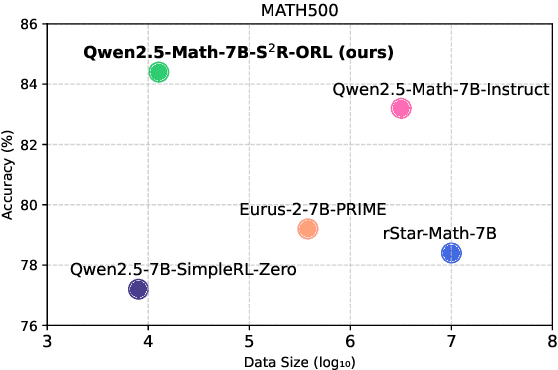
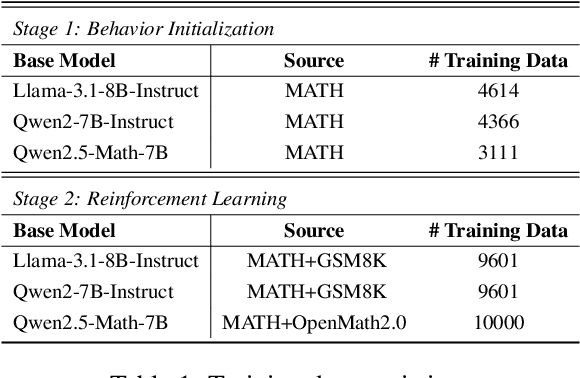
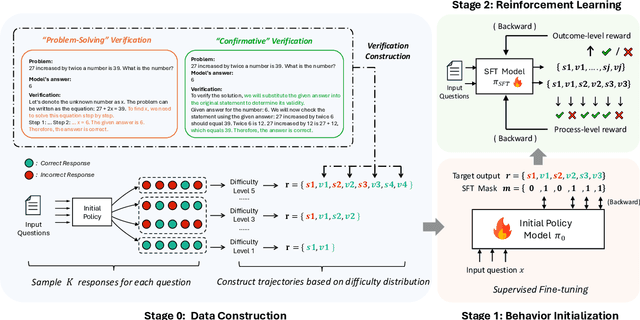
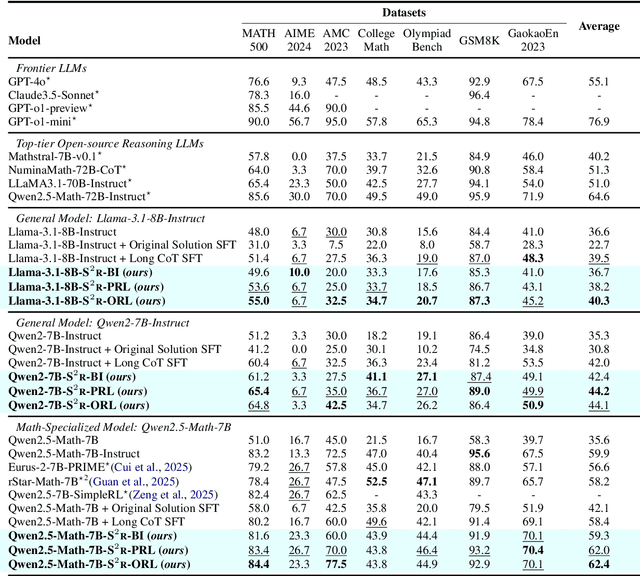
Abstract:Recent studies have demonstrated the effectiveness of LLM test-time scaling. However, existing approaches to incentivize LLMs' deep thinking abilities generally require large-scale data or significant training efforts. Meanwhile, it remains unclear how to improve the thinking abilities of less powerful base models. In this work, we introduce S$^2$R, an efficient framework that enhances LLM reasoning by teaching models to self-verify and self-correct during inference. Specifically, we first initialize LLMs with iterative self-verification and self-correction behaviors through supervised fine-tuning on carefully curated data. The self-verification and self-correction skills are then further strengthened by both outcome-level and process-level reinforcement learning, with minimized resource requirements, enabling the model to adaptively refine its reasoning process during inference. Our results demonstrate that, with only 3.1k self-verifying and self-correcting behavior initialization samples, Qwen2.5-math-7B achieves an accuracy improvement from 51.0\% to 81.6\%, outperforming models trained on an equivalent amount of long-CoT distilled data. Extensive experiments and analysis based on three base models across both in-domain and out-of-domain benchmarks validate the effectiveness of S$^2$R. Our code and data are available at https://github.com/NineAbyss/S2R.
Animate Anyone 2: High-Fidelity Character Image Animation with Environment Affordance
Feb 10, 2025



Abstract:Recent character image animation methods based on diffusion models, such as Animate Anyone, have made significant progress in generating consistent and generalizable character animations. However, these approaches fail to produce reasonable associations between characters and their environments. To address this limitation, we introduce Animate Anyone 2, aiming to animate characters with environment affordance. Beyond extracting motion signals from source video, we additionally capture environmental representations as conditional inputs. The environment is formulated as the region with the exclusion of characters and our model generates characters to populate these regions while maintaining coherence with the environmental context. We propose a shape-agnostic mask strategy that more effectively characterizes the relationship between character and environment. Furthermore, to enhance the fidelity of object interactions, we leverage an object guider to extract features of interacting objects and employ spatial blending for feature injection. We also introduce a pose modulation strategy that enables the model to handle more diverse motion patterns. Experimental results demonstrate the superior performance of the proposed method.
EMO2: End-Effector Guided Audio-Driven Avatar Video Generation
Jan 18, 2025



Abstract:In this paper, we propose a novel audio-driven talking head method capable of simultaneously generating highly expressive facial expressions and hand gestures. Unlike existing methods that focus on generating full-body or half-body poses, we investigate the challenges of co-speech gesture generation and identify the weak correspondence between audio features and full-body gestures as a key limitation. To address this, we redefine the task as a two-stage process. In the first stage, we generate hand poses directly from audio input, leveraging the strong correlation between audio signals and hand movements. In the second stage, we employ a diffusion model to synthesize video frames, incorporating the hand poses generated in the first stage to produce realistic facial expressions and body movements. Our experimental results demonstrate that the proposed method outperforms state-of-the-art approaches, such as CyberHost and Vlogger, in terms of both visual quality and synchronization accuracy. This work provides a new perspective on audio-driven gesture generation and a robust framework for creating expressive and natural talking head animations.
EraseAnything: Enabling Concept Erasure in Rectified Flow Transformers
Dec 29, 2024Abstract:Removing unwanted concepts from large-scale text-to-image (T2I) diffusion models while maintaining their overall generative quality remains an open challenge. This difficulty is especially pronounced in emerging paradigms, such as Stable Diffusion (SD) v3 and Flux, which incorporate flow matching and transformer-based architectures. These advancements limit the transferability of existing concept-erasure techniques that were originally designed for the previous T2I paradigm (\textit{e.g.}, SD v1.4). In this work, we introduce \logopic \textbf{EraseAnything}, the first method specifically developed to address concept erasure within the latest flow-based T2I framework. We formulate concept erasure as a bi-level optimization problem, employing LoRA-based parameter tuning and an attention map regularizer to selectively suppress undesirable activations. Furthermore, we propose a self-contrastive learning strategy to ensure that removing unwanted concepts does not inadvertently harm performance on unrelated ones. Experimental results demonstrate that EraseAnything successfully fills the research gap left by earlier methods in this new T2I paradigm, achieving state-of-the-art performance across a wide range of concept erasure tasks.
 Add to Chrome
Add to Chrome Add to Firefox
Add to Firefox Add to Edge
Add to Edge